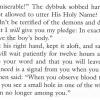3: Passage from story, “Warnings and Exorcisms for Driving Out a Dybbuk,” ca. 1748, translation from Yiddish.
This purportedly true story from the Ukrainian shtetl Khmelnik was transcribed from an eighteenth-century manuscript as part of Ansky’s ethnographic expedition. In the story, an epileptic teenager is possessed by a dybbuk that refuses to leave his body. The town’s rabbi and most pious men, the do-gooder Shaya among them, have gathered to exorcise it by binding the boy in rope, lighting seven black candles, blowing seven shoyfres [rams’ horns], cursing the dybbuk while holding seven Torah scrolls, and demanding it swear to leave the young man. In this scene, the spirit finally begins to relent.
Suggested activity: Read the excerpt or the entire story. Ask students: what seem to be some of the hallmarks of a dybbuk’s psyche and behavior? Which of these elements are also found in the dybbuk of Ansky's play, and what differs here? How might this folk legend, gathered by Ansky on his expedition, have influenced the writing of The Dybbuk?
Anonymous, “Warnings and Exorcisms for Driving Out a Dybbuk,” in The Dybbuk and the Yiddish Imagination: A Haunted Reader, ed. and trans. Joachim Neugroschel (Syracuse: Syracuse University Press, 2000), 111.

